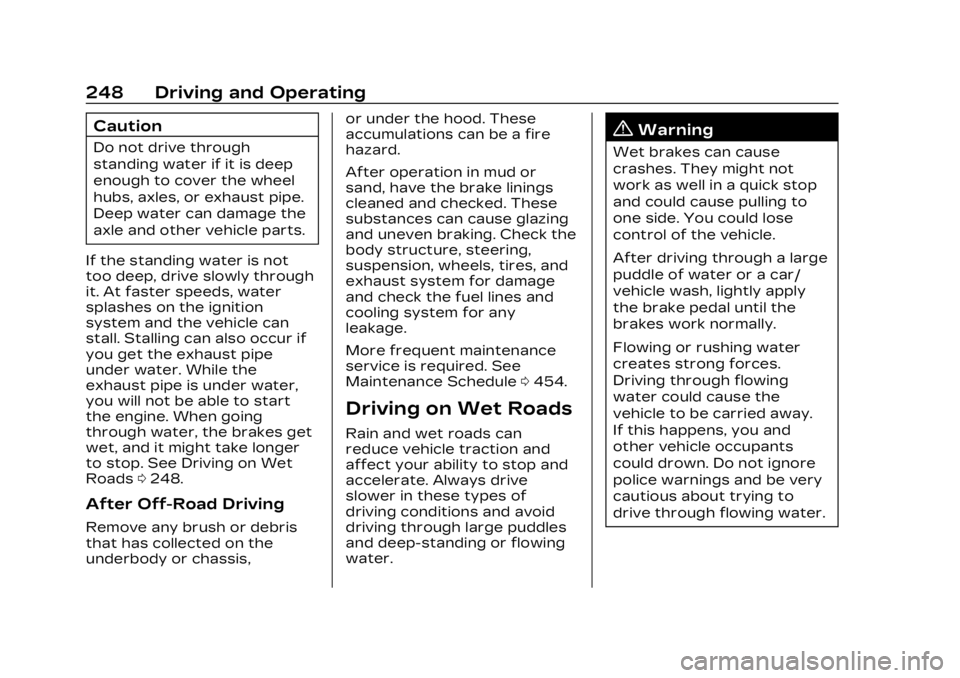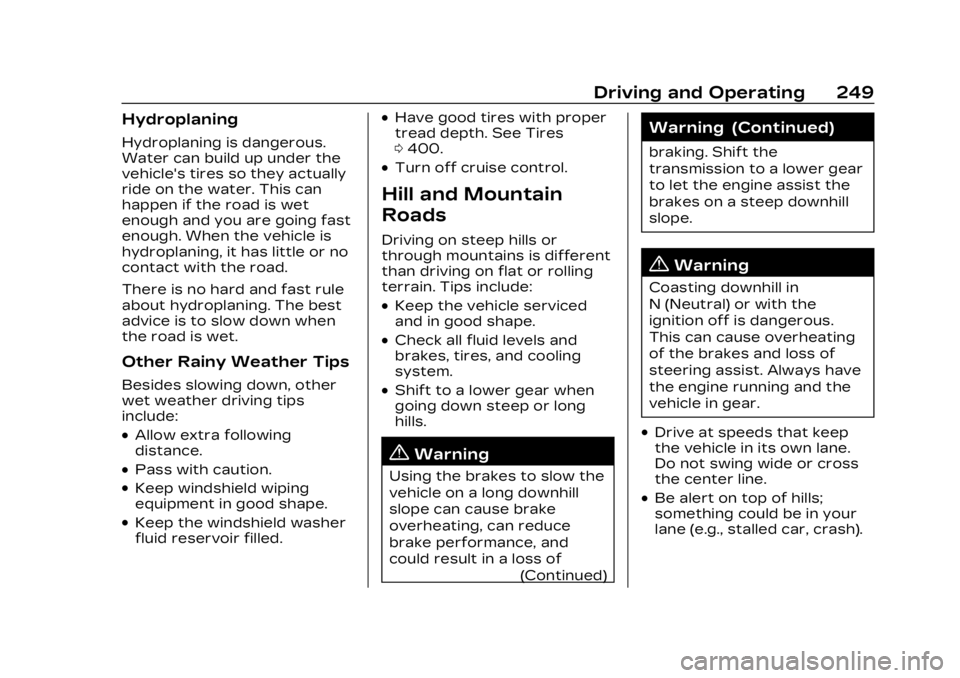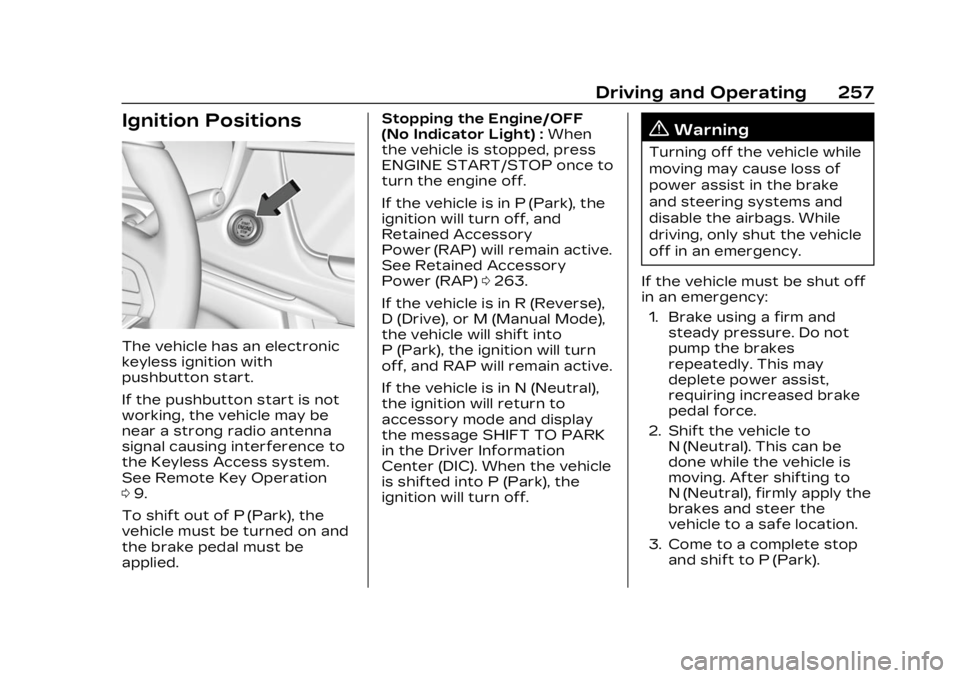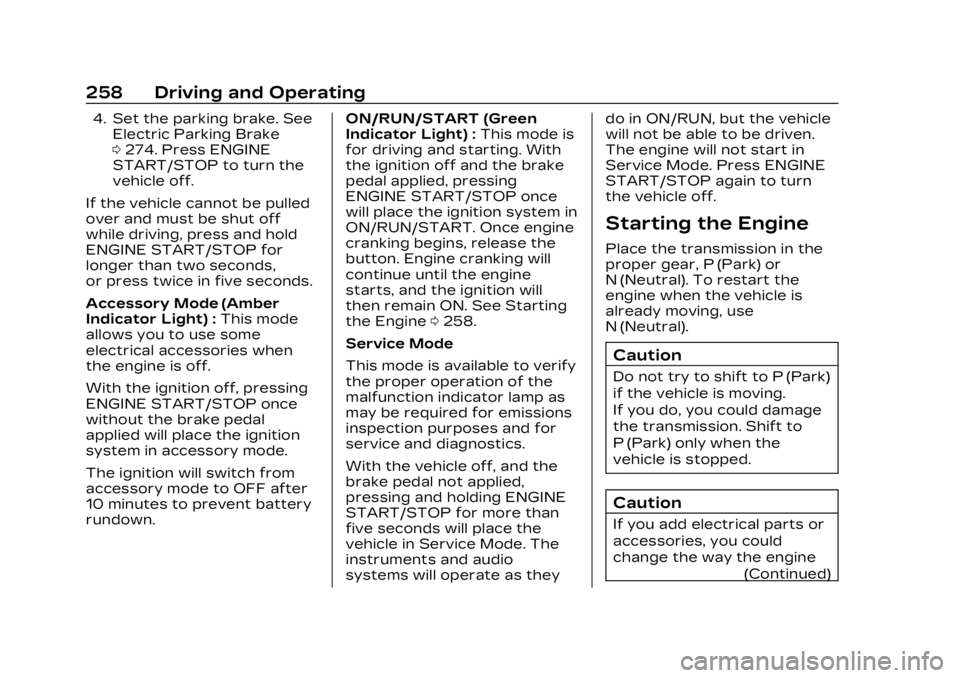engine CADILLAC XT6 2023 Service Manual
[x] Cancel search | Manufacturer: CADILLAC, Model Year: 2023, Model line: XT6, Model: CADILLAC XT6 2023Pages: 507, PDF Size: 6.49 MB
Page 242 of 507

Cadillac XT6 Owner Manual (GMNA-Localizing-U.S./Canada-16405819) -
2023 - CRC - 3/22/22
Driving and Operating 241
driving defensively is to wear
the seat belt. See Seat Belts
062.
.Assume that other road
users (pedestrians,
bicyclists, and other drivers)
are going to be careless and
make mistakes. Anticipate
what they may do and be
ready.
.Allow enough following
distance between you and
the driver in front of you.
.Focus on the task of driving.
Impaired Driving
Death and injury associated
with impaired driving is a
global tragedy.
{Warning
Drinking alcohol or taking
drugs and then driving is
very dangerous. Your
reflexes, perceptions,
attentiveness, and judgment
can be affected by even a
(Continued)
Warning (Continued)
small amount of alcohol or
drugs. You can have a
serious—or even fatal —
collision if you drive after
drinking or taking drugs.
Do not drive while under the
influence of alcohol or drugs,
or ride with a driver who has
been drinking or is impaired
by drugs. Find alternate
transportation home; or if
you are with a group,
designate a driver who will
remain sober.
Control of a Vehicle
Braking, steering, and
accelerating are important
factors in helping to control a
vehicle while driving.
Braking
Braking action involves
perception time and reaction
time. Deciding to push the brake pedal is perception time.
Actually doing it is
reaction time.
Average driver reaction time is
about three-quarters of a
second. In that time, a vehicle
moving at 100 km/h (60 mph)
travels 20 m (66 ft), which
could be a lot of distance in an
emergency.
Helpful braking tips to keep in
mind include:
.Keep enough distance
between you and the vehicle
in front of you.
.Avoid needless heavy
braking.
.Keep pace with traffic.
If the engine ever stops while
the vehicle is being driven,
brake normally but do not
pump the brakes. Doing so
could make the pedal harder
to push down. If the engine
stops, there will be some
power brake assist but it will
be used when the brake is
applied. Once the power assist
Page 245 of 507

Cadillac XT6 Owner Manual (GMNA-Localizing-U.S./Canada-16405819) -
2023 - CRC - 3/22/22
244 Driving and Operating
reducing vehicle speed by
shifting to a lower gear. Any
sudden changes could cause
the tires to slide.
Remember: Antilock brakes
help avoid only the
braking skid.
Off-Road Driving
All-Wheel Drive vehicles can
be used for off-road driving.
Vehicles without All-Wheel
Drive and vehicles not
equipped with All Terrain (AT)
or On-Off Road (OOR) tires
must not be driven off-road
except on a level, solid
surface. To contact the tire
manufacturer for more
information about the original
equipment tires, see the
Limited Warranty and Owner
Assistance Information
manual.
Controlling the vehicle is the
key to successful off-road
driving. One of the best ways
to control the vehicle is to
control the speed.
{Warning
When driving off-road,
bouncing and quick changes
in direction can easily throw
you out of position. This
could cause you to lose
control and crash. You and
your passengers should
always wear seat belts.
Before Driving Off-Road
.Have all necessary
maintenance and service
work completed.
.Fuel the vehicle, fill fluid
levels, and check inflation
pressure in all tires, including
the spare, if equipped.
.Read all the information
about All-Wheel Drive
vehicles in this manual.
.Make sure all underbody
shields, if equipped, are
properly attached.
.Know the local laws that
apply to off-road driving. To gain more ground
clearance if needed, it may be
necessary to remove the front
fascia lower air dam. However,
driving without the air dam
reduces fuel economy.
Caution
Operating the vehicle for
extended periods without
the front fascia lower air
dam installed can cause
improper airflow to the
engine. Reattach the front
fascia air dam after off-road
driving.
Loading the Vehicle for
Off-Road Driving
{Warning
.Unsecured cargo on the
load floor can be tossed
about when driving over
rough terrain. You or your
passengers can be struck
by flying objects. Secure
the cargo properly.
(Continued)
Page 247 of 507

Cadillac XT6 Owner Manual (GMNA-Localizing-U.S./Canada-16405819) -
2023 - CRC - 3/22/22
246 Driving and Operating
.Avoid turns that take the
vehicle across the incline of
the hill. Driving across an
incline puts more weight on
the downhill wheels which
could cause a downhill slide
or a rollover.
.Loose gravel, muddy spots,
or even wet grass can cause
the tires to slip sideways,
downhill. If the vehicle slips
sideways, it can hit
something and potentially
roll over.
.Hidden obstacles can make
the steepness of the incline
more severe. If a rock is
driven across with the uphill
wheels, or if the downhill
wheels drop into a rut or
depression, the vehicle can
tilt even more.
.If an incline must be driven
across, and the vehicle
starts to slide, turn downhill.
This should help straighten
out the vehicle and prevent
the side slipping.
.Never go downhill forward
or backward with the
transmission in N (Neutral).
The brakes could overheat
and you could lose control.
.When driving down a hill,
keep the vehicle headed
straight down. Use a low
gear because the engine will
work with the brakes to slow
the vehicle and help keep
the vehicle under control.
{Warning
Heavy braking when going
down a hill can cause your
brakes to overheat and fade.
This could cause loss of
control and you or others
could be injured or killed.
Apply the brakes lightly
when descending a hill and
use a low gear to keep
vehicle speed under control.
If the vehicle stalls on a hill: 1. Apply the brakes to stop the vehicle, and then apply
the parking brake. 2. Shift into P (Park) and then
restart the engine.
.If driving uphill when the
vehicle stalls, shift to
R (Reverse), release the
parking brake, and back
straight down.
.Never try to turn the
vehicle around. If the hill
is steep enough to stall
the vehicle, it is steep
enough to cause it to
roll over.
.If you cannot make it up
the hill, back straight
down the hill.
.Never back down a hill in
N (Neutral) using only
the brake.
.The vehicle can roll
backward quickly and
you could lose control.
.If driving downhill when
the vehicle stalls, shift to
a lower gear, release the
parking brake, and drive
straight down the hill.
Page 249 of 507

Cadillac XT6 Owner Manual (GMNA-Localizing-U.S./Canada-16405819) -
2023 - CRC - 3/22/22
248 Driving and Operating
Caution
Do not drive through
standing water if it is deep
enough to cover the wheel
hubs, axles, or exhaust pipe.
Deep water can damage the
axle and other vehicle parts.
If the standing water is not
too deep, drive slowly through
it. At faster speeds, water
splashes on the ignition
system and the vehicle can
stall. Stalling can also occur if
you get the exhaust pipe
under water. While the
exhaust pipe is under water,
you will not be able to start
the engine. When going
through water, the brakes get
wet, and it might take longer
to stop. See Driving on Wet
Roads 0248.
After Off-Road Driving
Remove any brush or debris
that has collected on the
underbody or chassis, or under the hood. These
accumulations can be a fire
hazard.
After operation in mud or
sand, have the brake linings
cleaned and checked. These
substances can cause glazing
and uneven braking. Check the
body structure, steering,
suspension, wheels, tires, and
exhaust system for damage
and check the fuel lines and
cooling system for any
leakage.
More frequent maintenance
service is required. See
Maintenance Schedule
0454.
Driving on Wet Roads
Rain and wet roads can
reduce vehicle traction and
affect your ability to stop and
accelerate. Always drive
slower in these types of
driving conditions and avoid
driving through large puddles
and deep-standing or flowing
water.
{Warning
Wet brakes can cause
crashes. They might not
work as well in a quick stop
and could cause pulling to
one side. You could lose
control of the vehicle.
After driving through a large
puddle of water or a car/
vehicle wash, lightly apply
the brake pedal until the
brakes work normally.
Flowing or rushing water
creates strong forces.
Driving through flowing
water could cause the
vehicle to be carried away.
If this happens, you and
other vehicle occupants
could drown. Do not ignore
police warnings and be very
cautious about trying to
drive through flowing water.
Page 250 of 507

Cadillac XT6 Owner Manual (GMNA-Localizing-U.S./Canada-16405819) -
2023 - CRC - 3/22/22
Driving and Operating 249
Hydroplaning
Hydroplaning is dangerous.
Water can build up under the
vehicle's tires so they actually
ride on the water. This can
happen if the road is wet
enough and you are going fast
enough. When the vehicle is
hydroplaning, it has little or no
contact with the road.
There is no hard and fast rule
about hydroplaning. The best
advice is to slow down when
the road is wet.
Other Rainy Weather Tips
Besides slowing down, other
wet weather driving tips
include:
.Allow extra following
distance.
.Pass with caution.
.Keep windshield wiping
equipment in good shape.
.Keep the windshield washer
fluid reservoir filled.
.Have good tires with proper
tread depth. See Tires
0400.
.Turn off cruise control.
Hill and Mountain
Roads
Driving on steep hills or
through mountains is different
than driving on flat or rolling
terrain. Tips include:
.Keep the vehicle serviced
and in good shape.
.Check all fluid levels and
brakes, tires, and cooling
system.
.Shift to a lower gear when
going down steep or long
hills.
{Warning
Using the brakes to slow the
vehicle on a long downhill
slope can cause brake
overheating, can reduce
brake performance, and
could result in a loss of
(Continued)
Warning (Continued)
braking. Shift the
transmission to a lower gear
to let the engine assist the
brakes on a steep downhill
slope.
{Warning
Coasting downhill in
N (Neutral) or with the
ignition off is dangerous.
This can cause overheating
of the brakes and loss of
steering assist. Always have
the engine running and the
vehicle in gear.
.Drive at speeds that keep
the vehicle in its own lane.
Do not swing wide or cross
the center line.
.Be alert on top of hills;
something could be in your
lane (e.g., stalled car, crash).
Page 251 of 507

Cadillac XT6 Owner Manual (GMNA-Localizing-U.S./Canada-16405819) -
2023 - CRC - 3/22/22
250 Driving and Operating
.Pay attention to special road
signs (e.g., falling rocks area,
winding roads, long grades,
passing or no-passing zones)
and take appropriate action.
Winter Driving
Driving on Snow or IceCaution
To avoid damage to the
wheels and brake
components, always clear
snow and ice from inside the
wheels and underneath the
vehicle before driving.
Snow or ice between the tires
and the road creates less
traction or grip, so drive
carefully. Wet ice can occur at
about 0 °C (32 °F) when
freezing rain begins to fall.
Avoid driving on wet ice or in
freezing rain until roads can be
treated. For Slippery Road Driving:
.Accelerate gently.
Accelerating too quickly
causes the wheels to spin
and makes the surface under
the tires slick.
.Turn on Traction Control.
See Traction Control/
Electronic Stability Control
0
276.
.Antilock Brake System (ABS)
improves vehicle stability
during hard stops, but the
brakes should be applied
sooner than when on dry
pavement. See Antilock
Brake System (ABS) 0273.
.Allow greater following
distance and watch for
slippery spots. Icy patches
can occur on otherwise clear
roads in shaded areas. The
surface of a curve or an
overpass can remain icy
when the surrounding roads
are clear. Avoid sudden
steering maneuvers and
braking while on ice.
.Turn off cruise control.
.Select All-Wheel Drive (AWD)
mode. See Driver Mode
Control 0278 and
All-Wheel Drive 0273.
Blizzard Conditions
Stop the vehicle in a safe
place and signal for help. Stay
with the vehicle unless there is
help nearby. Get help and keep
everyone in the vehicle safe:
.Turn on the hazard warning
flashers.
.Tie a red cloth to an outside
mirror.
{Warning
Snow can trap engine
exhaust under the vehicle.
This may cause exhaust
gases to get inside. Engine
exhaust contains carbon
monoxide (CO), which cannot
be seen or smelled. It can
cause unconsciousness and
even death.
(Continued)
Page 252 of 507

Cadillac XT6 Owner Manual (GMNA-Localizing-U.S./Canada-16405819) -
2023 - CRC - 3/22/22
Driving and Operating 251
Warning (Continued)
If the vehicle is stuck
in snow:
.Clear snow from the base
of the vehicle, especially
any blocking the
exhaust pipe.
.Open a window about
5 cm (2 in) on the vehicle
side that is away from the
wind, to bring in fresh air.
.Fully open the air outlets
on or under the
instrument panel.
.Adjust the climate control
system to circulate the air
inside the vehicle and set
the fan speed to the
highest setting. See
“Climate Control Systems.”
For more information about
CO, see Engine Exhaust
0 265.
To save fuel, run the engine
for short periods to warm the
vehicle and then shut the engine off and partially close
the window. Moving about to
keep warm also helps.
If it takes time for help to
arrive, when running the
engine, push the accelerator
pedal slightly so the engine
runs faster than the idle
speed. This keeps the battery
charged to restart the vehicle
and to signal for help with the
headlamps. Do this as little as
possible, to save fuel.
If the Vehicle Is Stuck
Slowly and cautiously spin the
wheels to free the vehicle
when stuck in sand, mud, ice,
or snow.
The Traction Control System
(TCS) can often help to free a
stuck vehicle. See Traction
Control/Electronic Stability
Control
0276.
If TCS cannot free the vehicle,
turn TCS off and use the
rocking method. See “Rocking
the Vehicle to Get it Out”
following.
{Warning
If the vehicle's tires spin at
high speed, they can
explode, and you or others
could be injured. The vehicle
can overheat, causing an
engine compartment fire or
other damage. Spin the
wheels as little as possible
and avoid going above
56 km/h (35 mph).
Rocking the Vehicle to Get
it Out
Turn the steering wheel left
and right to clear the area
around the front wheels. Turn
off any traction system. Shift
back and forth between
R (Reverse) and a low forward
gear, spinning the wheels as
little as possible. To prevent
transmission wear, wait until
the wheels stop spinning
before shifting gears. Release
the accelerator pedal while
shifting, and press lightly on
the accelerator pedal when
Page 257 of 507

Cadillac XT6 Owner Manual (GMNA-Localizing-U.S./Canada-16405819) -
2023 - CRC - 3/22/22
256 Driving and Operating
Warning (Continued)
.Do not leave an
unsecured child
restraint in the vehicle.
.Secure loose items in
the vehicle.
.Do not leave a seat
folded down unless
needed.
Starting and
Operating
New Vehicle Break-In
Caution
The vehicle does not need
an elaborate break-in. But it
will perform better in the
long run if you follow these
guidelines:
.Do not drive at any one
constant speed, fast or
slow, for the first 800 km
(500 mi). Do not make(Continued)
Caution (Continued)
full-throttle starts. Avoid
downshifting to brake or
slow the vehicle.
.Avoid making hard stops
for the first 300 km
(200 mi) or so. During this
time the new brake linings
are not yet broken in. Hard
stops with new linings can
mean premature wear and
earlier replacement.
Follow this breaking-in
guideline every time you
get new brake linings.
.Do not tow a trailer during
break-in. See Trailer
Towing0351 for the
trailer towing capabilities
of the vehicle and more
information.
Following break-in, engine
speed and load can be
gradually increased. On new vehicles, the various
mechanical and electrical
systems experience a
“break-in”
period during the
first 6 400 km (4,000 mi) of
routine driving. As the vehicle
is driven, the mechanical
systems adjust to provide
optimal fuel economy and
transmission shift
performance.
Electrical systems will adapt
and calibrate during the
break-in period. A one-time
occurrence of clicks and
similar vehicle noises is normal
during this process.
Normal driving charges the
vehicle’s battery to achieve
the best operation of the
vehicle, including fuel economy
and the Stop/Start System.
See Stop/Start System 0259.
Page 258 of 507

Cadillac XT6 Owner Manual (GMNA-Localizing-U.S./Canada-16405819) -
2023 - CRC - 3/22/22
Driving and Operating 257
Ignition Positions
The vehicle has an electronic
keyless ignition with
pushbutton start.
If the pushbutton start is not
working, the vehicle may be
near a strong radio antenna
signal causing interference to
the Keyless Access system.
See Remote Key Operation
09.
To shift out of P (Park), the
vehicle must be turned on and
the brake pedal must be
applied. Stopping the Engine/OFF
(No Indicator Light) :
When
the vehicle is stopped, press
ENGINE START/STOP once to
turn the engine off.
If the vehicle is in P (Park), the
ignition will turn off, and
Retained Accessory
Power (RAP) will remain active.
See Retained Accessory
Power (RAP) 0263.
If the vehicle is in R (Reverse),
D (Drive), or M (Manual Mode),
the vehicle will shift into
P (Park), the ignition will turn
off, and RAP will remain active.
If the vehicle is in N (Neutral),
the ignition will return to
accessory mode and display
the message SHIFT TO PARK
in the Driver Information
Center (DIC). When the vehicle
is shifted into P (Park), the
ignition will turn off.
{Warning
Turning off the vehicle while
moving may cause loss of
power assist in the brake
and steering systems and
disable the airbags. While
driving, only shut the vehicle
off in an emergency.
If the vehicle must be shut off
in an emergency: 1. Brake using a firm and steady pressure. Do not
pump the brakes
repeatedly. This may
deplete power assist,
requiring increased brake
pedal force.
2. Shift the vehicle to N (Neutral). This can be
done while the vehicle is
moving. After shifting to
N (Neutral), firmly apply the
brakes and steer the
vehicle to a safe location.
3. Come to a complete stop and shift to P (Park).
Page 259 of 507

Cadillac XT6 Owner Manual (GMNA-Localizing-U.S./Canada-16405819) -
2023 - CRC - 3/22/22
258 Driving and Operating
4. Set the parking brake. SeeElectric Parking Brake
0274. Press ENGINE
START/STOP to turn the
vehicle off.
If the vehicle cannot be pulled
over and must be shut off
while driving, press and hold
ENGINE START/STOP for
longer than two seconds,
or press twice in five seconds.
Accessory Mode (Amber
Indicator Light) : This mode
allows you to use some
electrical accessories when
the engine is off.
With the ignition off, pressing
ENGINE START/STOP once
without the brake pedal
applied will place the ignition
system in accessory mode.
The ignition will switch from
accessory mode to OFF after
10 minutes to prevent battery
rundown. ON/RUN/START (Green
Indicator Light) :
This mode is
for driving and starting. With
the ignition off and the brake
pedal applied, pressing
ENGINE START/STOP once
will place the ignition system in
ON/RUN/START. Once engine
cranking begins, release the
button. Engine cranking will
continue until the engine
starts, and the ignition will
then remain ON. See Starting
the Engine 0258.
Service Mode
This mode is available to verify
the proper operation of the
malfunction indicator lamp as
may be required for emissions
inspection purposes and for
service and diagnostics.
With the vehicle off, and the
brake pedal not applied,
pressing and holding ENGINE
START/STOP for more than
five seconds will place the
vehicle in Service Mode. The
instruments and audio
systems will operate as they do in ON/RUN, but the vehicle
will not be able to be driven.
The engine will not start in
Service Mode. Press ENGINE
START/STOP again to turn
the vehicle off.
Starting the Engine
Place the transmission in the
proper gear, P (Park) or
N (Neutral). To restart the
engine when the vehicle is
already moving, use
N (Neutral).
Caution
Do not try to shift to P (Park)
if the vehicle is moving.
If you do, you could damage
the transmission. Shift to
P (Park) only when the
vehicle is stopped.
Caution
If you add electrical parts or
accessories, you could
change the way the engine
(Continued)